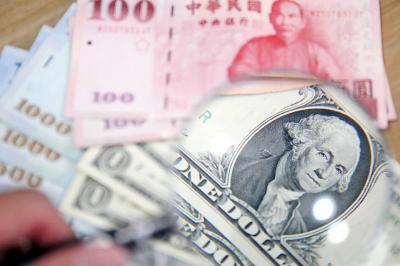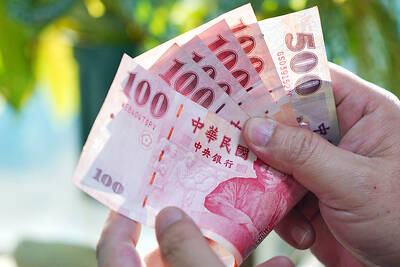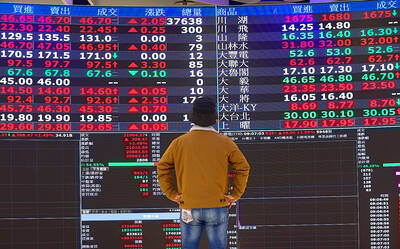The nation’s export orders fell 7.4 percent annually to US$27.67 billion last month, better than the government’s expectation of a 10 percent decline, due to improving demand for smartphones and laptops, the Ministry of Economic Affairs said yesterday.
The latest results represent the 11th consecutive month of contraction in export orders, a critical economic indicator which sheds light on actual shipments one to three months ahead.
“The 7.4 percent annual decline was smaller than our previous forecast, mainly because of recovering demand for notebooks from European and US markets, and increasing orders for chips used in smartphones from China,” the ministry’s Department of Statistics Director-General Lin Lee-jen (林麗貞) told a news conference.
Supported by higher demand for notebooks, the annual decline for Taiwan’s information and communication sector eased to 1.8 percent last month from the 11.2 percent fall recorded a month earlier, Lin said.
She said the contraction in electronics products also narrowed to 1.5 percent from the 7.9 percent decline in January on the back of robust demand for solar products and chips used in smartphones.
However, orders for Taiwan’s basic metals, petrochemicals, machinery goods, precision instruments and plastic and rubber products still remained in negative territory, with the decline in orders for precision instruments deteriorating, Lin said.
Orders for Taiwan’s precision instruments plunged 32.5 percent to US$1.35 billion last month from a year earlier, marking the fastest pace of contraction since April in 2009, dragging down by tepid demand for panels from China, the ministry said.
“The rising competition from China and falling average selling prices for panel products weakened orders for Taiwan’s panel products last month,” Lin said.
By export destination, orders from the US contracted for the fourth straight month to US$7.56 billion last month, primarily due to weak demand for smartphones over the past few months, Lin said.
Orders from China and Hong Kong, Europe and Japan all fell last month from a year ago, the data showed.
Orders from ASEAN were the only bright spot with orders growing by 0.4 percent from a year earlier, driven by demand for notebooks and smartphones, Lin said.
The ministry expects export orders to increase this month from last month, with the decline slowing to less than 10 percent, Lin said, citing an internal survey of local firms.
The survey found 68 percent of local manufacturers said they expect to receive more orders this month from last month.

The US dollar was trading at NT$29.7 at 10am today on the Taipei Foreign Exchange, as the New Taiwan dollar gained NT$1.364 from the previous close last week. The NT dollar continued to rise today, after surging 3.07 percent on Friday. After opening at NT$30.91, the NT dollar gained more than NT$1 in just 15 minutes, briefly passing the NT$30 mark. Before the US Department of the Treasury's semi-annual currency report came out, expectations that the NT dollar would keep rising were already building. The NT dollar on Friday closed at NT$31.064, up by NT$0.953 — a 3.07 percent single-day gain. Today,

‘SHORT TERM’: The local currency would likely remain strong in the near term, driven by anticipated US trade pressure, capital inflows and expectations of a US Fed rate cut The US dollar is expected to fall below NT$30 in the near term, as traders anticipate increased pressure from Washington for Taiwan to allow the New Taiwan dollar to appreciate, Cathay United Bank (國泰世華銀行) chief economist Lin Chi-chao (林啟超) said. Following a sharp drop in the greenback against the NT dollar on Friday, Lin told the Central News Agency that the local currency is likely to remain strong in the short term, driven in part by market psychology surrounding anticipated US policy pressure. On Friday, the US dollar fell NT$0.953, or 3.07 percent, closing at NT$31.064 — its lowest level since Jan.

The New Taiwan dollar and Taiwanese stocks surged on signs that trade tensions between the world’s top two economies might start easing and as US tech earnings boosted the outlook of the nation’s semiconductor exports. The NT dollar strengthened as much as 3.8 percent versus the US dollar to 30.815, the biggest intraday gain since January 2011, closing at NT$31.064. The benchmark TAIEX jumped 2.73 percent to outperform the region’s equity gauges. Outlook for global trade improved after China said it is assessing possible trade talks with the US, providing a boost for the nation’s currency and shares. As the NT dollar

The Financial Supervisory Commission (FSC) yesterday met with some of the nation’s largest insurance companies as a skyrocketing New Taiwan dollar piles pressure on their hundreds of billions of dollars in US bond investments. The commission has asked some life insurance firms, among the biggest Asian holders of US debt, to discuss how the rapidly strengthening NT dollar has impacted their operations, people familiar with the matter said. The meeting took place as the NT dollar jumped as much as 5 percent yesterday, its biggest intraday gain in more than three decades. The local currency surged as exporters rushed to